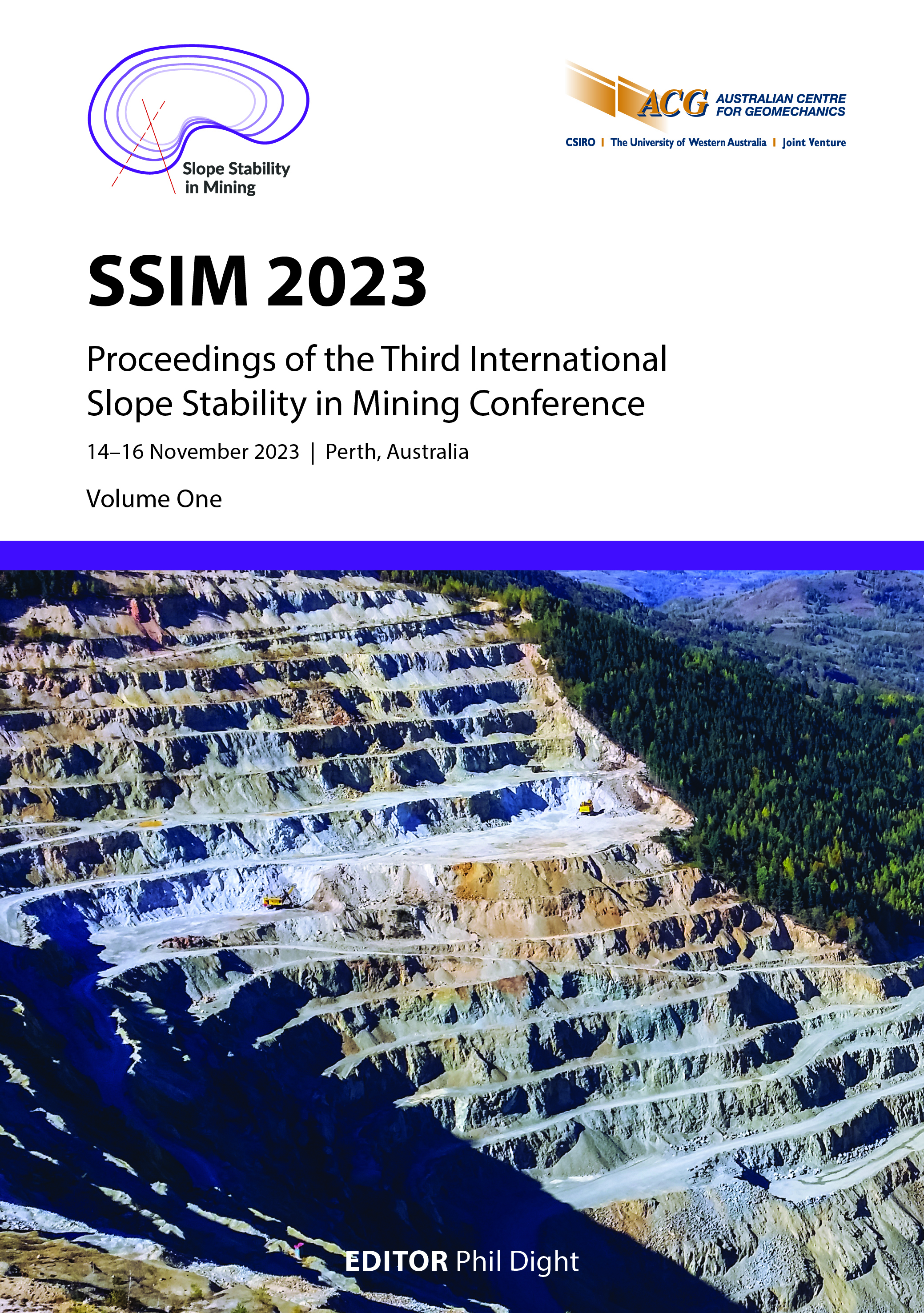Critical challenges impacting the advancement of slope design reliability

|
Authors: Moffitt, K |
DOI https://doi.org/10.36487/ACG_repo/2335_0.02
Cite As:
Moffitt, K 2023, 'Critical challenges impacting the advancement of slope design reliability', in PM Dight (ed.), SSIM 2023: Third International Slope Stability in Mining Conference, Australian Centre for Geomechanics, Perth, pp. 23-34, https://doi.org/10.36487/ACG_repo/2335_0.02
Abstract:
There have been many recent and ongoing advances in the area of slope stability, including tools and processes for slope management, rock mass characterisation, stability assessments, and selection of design acceptance criteria. Despite the many advances and ongoing research in the field, there remain several fundamental unresolved challenges that impact the design and assessment of pit wall stability. In this paper, these have been categorised into six key areas: Assessment and communication of risk: a risk-based approach to slope design has become more common practice, particularly with advances in approaches to calculating a Probability of Failure (PoF). However, the PoF is not quantified in a consistent manner within our industry and can present a false or misleading view of project risk to stakeholders and decision-makers. Reliance on technology: new and emerging technologies have provided many benefits to our industry but, in some cases, technology has advanced faster than the ability to answer more fundamental and basic questions related to material characterisation and slope behaviour. Treatment of damage/overbreak zone: the rock mass strength and hydraulic conductivity of the near-surface ‘rind’ around the pit wall is impacted by damage resulting from blasting and stress relaxation. The depth and extent of damage/disturbance are very difficult to test/evaluate. Although the assumptions may significantly influence predictions of inter-ramp scale Factors of Safety (FoS), there are no consistent approaches or standards for the treatment of this zone in stability analyses. Integration/communication: within our complex mining environments, disconnects often exist between disciplines but also between the technical teams, management and stakeholders. There are also obstacles to information sharing and collaboration. These can reduce efficiency, design reliability, and the speed of innovation. Increased demand for minerals: electrification and the demand for resources are arguably greater than they have ever been. With this increase in demand comes additional challenges related to developing deeper mines and steeper pit walls in increasingly remote environments. Reducing technical workforce: the industry is currently under-resourced. The talent pool is shrinking while mine complexity is increasing. It is critical that the industry take steps in the short term to address this skills shortage. This paper is not intended to prescribe or present solutions to these issues. Rather it is intended as a means to engage and challenge the industry to discuss and consider these issues. Based on research along with the author’s experience and discussions with industry leaders, this paper explores each of these issues, how they may impact the reliability of slope designs, and ideas for consideration to move the industry along a path to overcoming these challenges.
Keywords: slope stability, geotechnical risk, technology, slope design reliability
References:
Abenov, T, Franklin-Hensler, M, Grabbert, T & Larrat, T 2023, ‘Has mining lost its luster? Why talent is moving elsewhere and how to bring them back’, 14 February 2023, McKinsey & Company, viewed 20 September 2023,
Ahmad, M 2023, ‘Top 10 mining trends in 2023’, 26 April 2023, Mining Digital, viewed 20 September 2023,
Azevedo, M, Baczynska, M, Bingoto, P, Callaway, G, Hoffman, K & Ramsbottom, O 2022, ‘The raw-materials challenge: how the metals and mining sector will be at the core of enabling the energy transition’, 10 January 2022, McKinsey & Company, viewed 20 September 2023,
BloombergNEF 2022, ‘Race to net zero: the pressures of the battery boom in five charts’, 21 July 2022, viewed 20 September 20 2023,
/en/voices/mining-for-talent-en/.
Guzman, RS & Perez, PG 2015, ‘Towards a mechanically based definition of the disturbance factor using the “Slope Model” Lattice Code’, Proceedings of the ISRM Regional Symposium – 8th South American Congress on Rock Mechanics, pp. 3–10.
Hoek, E, Carranza-Torres, C & Corkum, B 2002, ‘Hoek-Brown failure criterion – 2002 eition’, Proceedings of the Fifth North American Rock Mechanics Symposium, pp. 267–273.
Hoek, E & Brown, ET 2018, ‘The Hoek-Brown failure criterion and GSI – 2018 edition’, Journal of Rock Mechanics and Geotechnical Engineering, vol. 11, no. 3, pp. 445–463.
Lorig, L, Potyondy, D & Varun 2020, ‘Quantifying excavation-induced rock mass damage in large open pits’, in PM Dight (ed.), Slope Stability 2020: Proceedings of the 2020 International Symposium on Slope Stability in Open Pit Mining and Civil Engineering, Australian Centre for Geomechanics, Perth, pp. 969–982,
Macciotta, R, Creighton, A & Martin, CD 2020, ‘Design acceptance criteria for operating open-pit slopes: an update’, CIM Journal, vol. 11, no. 4, pp. 248–265.
Rose, ND, Scholz, M, Burden, M, King, M, Maggs, C & Havaej, M 2018, ‘Quantifying transitional rock mass disturbance in open pit slopes related to mining excavation’, Proceedings of Slope Stability 2018 – XIV International Congress on Energy and Mineral Resources, Asociación Nacional de Ingenieros de Minas, Seville, pp. 1273–1288.
Wesseloo, J & Read, J 2009, ‘Acceptance criteria’, in J Read & P Stacey (eds), Guidelines for Open Pit Slope Design, CRC Press, Boca Raton, pp. 221–236.
© Copyright 2025, Australian Centre for Geomechanics (ACG), The University of Western Australia. All rights reserved.
View copyright/legal information
Please direct any queries or error reports to repository-acg@uwa.edu.au
View copyright/legal information
Please direct any queries or error reports to repository-acg@uwa.edu.au

